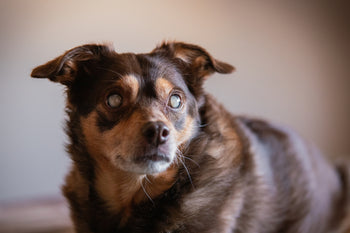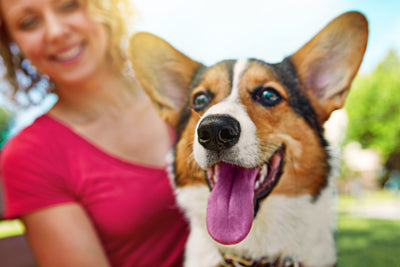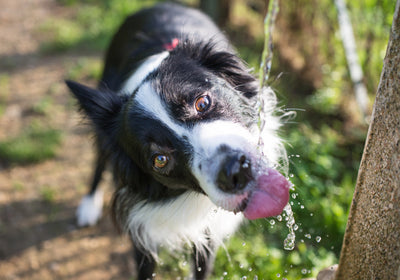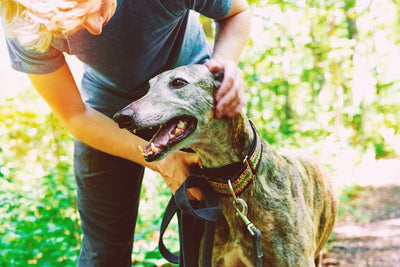How to Know if Your Dog is Going Blind (and How to Care for Them)

Just like people, dogs can go blind. And when it does happen, it’s understandable to feel overwhelmed, dismayed, sad and maybe even angry. I know of a woman whose 7-year-old dog suddenly went blind: he was her agility dog. Of course, she was upset – she felt bad for her dog and sad they could no longer do the sport they both loved. But it happens. Thankfully, she was very aware of her dog and noticed it at the first sign, so she could be ready.
Depending on why your dog is going blind – and there are lots of causes – it may happen gradually or it could be sudden. For example, older dogs may gradually go blind due to cataracts. Or, if you have a Chihuahua such as the woman I mentioned, your dog may go blind overnight due to SARD (Sudden Acquired Retinal Degeneration). There are other diseases that also cause rapid blindness, including immune-mediated retinal detachment syndrome and diabetes mellitus, dogs with the latter can go blind in less than 48 hours.
How to Know If Your Dog is Going Blind
Sometimes it can be hard to tell if your dog is going blind or is blind already. In the case of SARD, for example, the dog’s eyes look no different than when he could see, so there is no visual tell. With other diseases, like cataracts, you will notice your dog’s eyes getting cloudy, just like a person’s. In this case, that visual appearance of the eye may be your first clue.
If your dog has a yearly check up (which he should!), your vet should be checking his eyes and may find something sooner than you can detect. While early detection does not matter for some diseases, like SARDS which has no cure, some blindness is reversable, so it’s good to have your dog’s eyes check at least once a year.
In the meantime, there may be some other behavioural signs that your dog is going blind that you can look for. Common things to watch for include:
· Your dog that used to be able to catch a treat or a ball in the air, misses. (This is how the women with the Chihuahua knew something was wrong: One day he stopped catching his treat in the air).
· Your dog appears uncoordinated, maybe bumps into things or has trouble getting onto the couch or bed.
· Your dog is hesitant while moving.
· Your dog doesn’t look at you when you are talking to him.
· Your dog is using his nose more, sniffing more, reaching out to touch things more.
· Your dog may choose to stay closer to you, be clingier, than before.
· Your dog may even get snappy or growling, caused by anxiety from not being able to see as well.
· Seems startled if you are too quiet when approaching them, or when woken up.
Noticing these little things may help you know if your dog is going blind. If you see these things, it’s time for a vet appointment to get those eyes checked!
How to Care for A Blind Dog
Once it’s been determined that your dog is losing or has lost his sight, you may wonder how to help him live his life as normal as possible. You may even be overwhelmed. Thankfully, our four-legged best friends seem to be pretty good at adapting to the loss of one of their senses. Lucky for them, they have a very good sense of smell and many use their noses to make up for the lack of sight.
There are definitely things you can do to help your dog as she adjusts to her new life, and to make sure no injuries happen. The following are some good tips for caring for a blind dog:
· Limit moving furniture around in the house, so your dog can memorize where things are. If you do have to move furniture, lead your dog through the new pathways several times so he can learn them.
· Put down rugs or some type of flooring with a different texture, that gives your dog a path to follow.
· Don’t move your dog’s water, food, dog beds or crate.
· When adding something new to the house, like a new chair, lead your dog up to it, so they know it’s there.
· Put baby gates at top of stairs so that your dog can’t fall down them. Take the time to lead your dog up and down the stairs and see how they do. Some dogs do fine, others—especially senior dogs—may find stairs too difficult without sight.
· If your backyard has stairs, considering installing a ramp that will be much easier for your dog to use.
· Be sure to remove any hazards that your dog may accidentally get into, or fall from. This may include installing fence on a raised porch, removing sharp objects that your dog may walk into or step on, or low hanging branches in the yard that they could get hung up on.
· Teaching your dog verbal directions is great. Things like, left, right, stop and go, can really help. If your dog was used to hand signals for other behaviours like sit, come and stay, you may have to reteach these with verbal cues.
· Since your dog is going to be using his nose more, you can use that to help your dog out. For example, put a bit of lavender essential oil on all her beds. This way, if they get moved, she knows what that scent means and can follow it to find her bed.
· Teaching your dog a phrase that lets her know a person is reaching out to pet them or pick them up, like “greet” or “say hi” can help avoid startling a dog. Startled dogs may snap or even bite, with good reason. It’s our job to let our blind dogs know what we are about to do to them.
· Speak to your dog when you approach, so they know you are coming.
· Leaving the TV on when you leave the house can help as well: The dog knows where the TV is so it gives them a reference point.
· When you leave the house, you may want to shrink the area they normally have. When your dog had sight, he may have had the run of the house, but now that he is blind, for his safety you may want to limit him to one or two rooms that have been thoroughly proofed. If your dog is crate-trained, putting them in their crate while you are gone for a short while is a good option too.
While it can be scary, finding out your dog is blind does not mean his best days are behind you. If you see the above signs that your dog is going blind, go to the vet. Then, work on caring for your blind dog with the above tips. Once you and your dog have a routine down, things will go back to normal. The woman with her Chihuahua now does nose works with him and he loves it. You can both lead a full life with just a few minor adjustments in your daily life.








